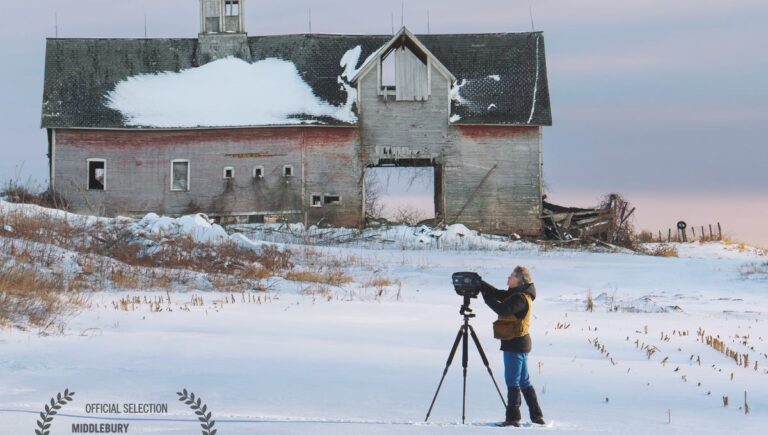Shelburne based mostly photographer Jim Westphalen revels in “the sweetness in decay,” discovering artwork within the patina of a dilapidated barn’s roof or a snow-covered grain elevator. Westphalen’s physique of labor “visually preserves” buildings that maintain histories of rural America, as they slowly crumble to rubble. For the previous 4 years, although, he has been exploring a brand new medium: movie.
Westphalen’s documentary Vanish: Disappearing Icons of a Rural America, is premiering at Middlebury New Filmmakers Pageant on Thursday, Aug. 24 at 11:30 a.m. in Middlebury Faculty’s Dana Auditorium in Middlebury. Within the movie, Westphalen tells the tales behind the buildings he images – too giant to suit onto gallery placards – in addition to his processes in capturing them.
“The movie is equal elements historical past, images, anthropology and storm chasing. It’s totally a lot these tales about these folks and these vanishing cultures, you already know,” Westphalen mentioned. “That tradition of the mom-and-pop farmer is disappearing together with the buildings.”
Capturing the check of time
Starting with an epigraph from the late A. Hale Johnson, a painter, close-friend and inspiration to Westphalen, the opening photographs of the documentary depict Westphalen stalking by way of a snow-covered discipline in Sheldon. He heads for an outdated cow-barn, lugging his classic 4×5 discipline digital camera over his shoulder.
Westphalen jokes that he resembles the old-timey photographer with a black material over his head – and he actually does.
“There’s one thing about utilizing this time-tested software to seize the souls of those time worn buildings that simply feels proper,” he says within the documentary voice over.
The outdated cow barn was as soon as half of a bigger farm advanced, the remainder of which burned down in a 1910 fireplace – a typical, tragic finish for a lot of of Vermont’s wood buildings. If not by fireplace or builders – as is the case for a three-story rooster coop demolished within the matter of some months – it’s climate that places buildings to the check.
“You gained’t discover me out too many days taking pictures on a blue-sky sunny day as a result of I prefer to {photograph} in tough components whether or not it’s a snowstorm or if lightning and thunder hits throughout me as a result of, you already know, that conveys what these buildings have withstood for many years and typically centuries,” Westphalen mentioned.
“It’s that vulnerability, as a result of they’re uncovered to the unrelenting components constantly.”
Vermont to Montana and again once more
The movie takes viewers from the historic Glen Dale Farms in Cornwall to a powder home in Pony, Montana, to a search out filth roads for a prairie church in Kremlin, Montana, and again to Vermont, by way of windstorms, thunderstorms, snowstorms, and baking solar.
Montana and Vermont are basically completely different landscapes, but Westphalen shortly discovered similarities within the phenomenon of “vanishing,” in the best way a selected cultural heritage fades on the assorted faces of those outdated buildings.
“The vernacular of the buildings could be very distinctive to the panorama of the West,” he mentioned. “The grain elevator or the prairie church, you don’t discover these sorts of buildings right here.”
No matter place, the sentiment stays that there’s a deep and inherent loss inside these degrading buildings that thrived in a distinct time, had been as soon as the spine of communities.
The movie begs the query of why these buildings appear to vanish with nobody batting a watch.
“In spite of everything, weren’t all these buildings as soon as somebody’s dream?” Westphalen mentioned.
Westphalen not solely captures loss, however hope in addition to the documentary chronicles heart-filled preservation efforts.
The making of the film
From images to filmmaking, Westphalen focuses on the identical ideas of composition and prioritizes aesthetic selection. His images are woven all through the movie, with nonetheless photographs fading into reside motion.
“It’s all about telling the story. As you inform this factor of the story, nicely, how do I get from this factor to the following factor? And what does it appear like visually?” Westphalen mentioned.
He runs his high quality artwork images enterprise with the assistance of full time worker Invoice Killon, and two half time staff, who serendipitously all had some background in filmmaking and stepped into all completely different roles for the documentary– from pre-production, to enhancing, to cinematography, to post-production.
Native composer Christopher Hawthorn created an unique rating to accompany the visible fantastic thing about the movie, enlisting the assistance of Vermont Symphony Orchestra, resulting in an suave collaboration between the 2 mediums.
Extra of Westphalen’s work
The Vanish physique of labor – the movie and assortment of pictures – follows his portfolios entitled Somewhere in America and Coastline, which name on related aesthetics and traditions.
Photos from Vanish are on show at Edgewater Gallery in Middlebury and Robert Paul galleries in Stowe. Westphalen hopes to proceed making artwork from fading treasures so long as he can.
“So long as I’m capable of carry my 40 pound digital camera out into the sector, as a result of it’s a ardour,” he mentioned “It’s actually this labor of affection. I name it my love tune to the light, to the crumbling, to the peeling, and the rusted.”
Should you go:
- WHAT: Vanish: Disappearing Icons of a Rural America premiere at Middlebury New Filmmakers Festival.
- WHEN: 11:30 a.m., Thursday, Aug. 24.
- WHERE: Dana Auditorium, 365 Faculty St., Middlebury.
Should you miss the premiere at Middlebury New Filmmakers Pageant, the movie will play at Stowe Cinema 3plex on Sept. 2 at 6 p.m. and at Pentangle Arts in Woodstock on Oct. 7 at 7:30 p.m.
Contact Kate Sadoff at ksadoff@gannett.com.


